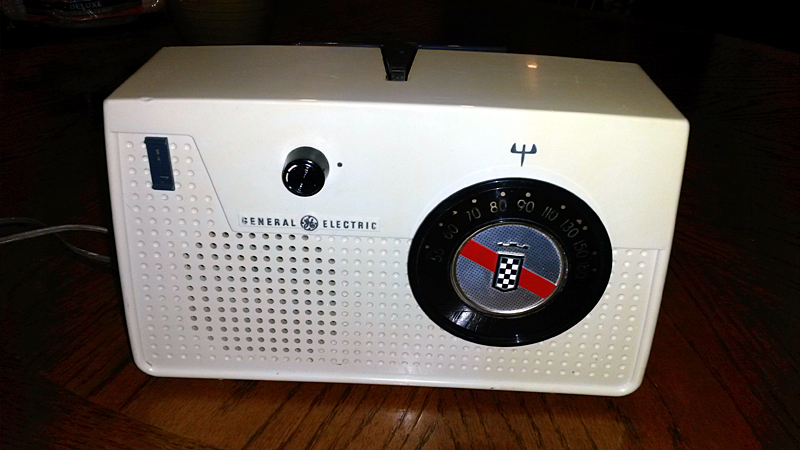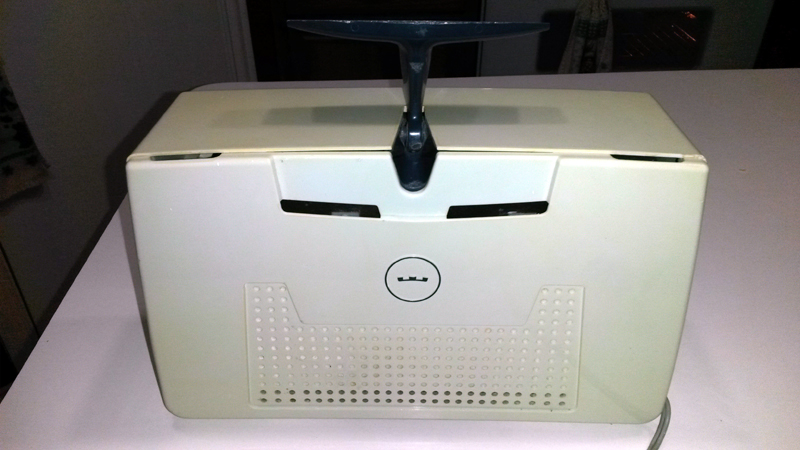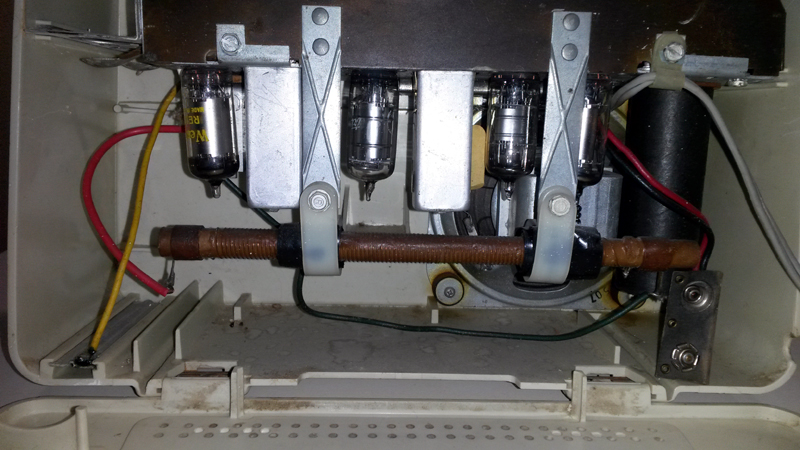General Discussion
Forum home - Go back to General discussion
|
Please help identify antique radio
|
|
|
Return to top of page · Post #: 1 · Written at 11:36:49 PM on 24 November 2015.
|
|
|
|
Location: Little Elm, US
Member since 23 November 2015 Member #: 1830 Postcount: 2 |
|
I was directed to you in hopes you could help me identify an antique radio I recently acquired . Please see pictures. I cannot find any information on this and there is no tags or model numbers on it.    |
|
|
Return to top of page · Post #: 2 · Written at 12:55:16 AM on 25 November 2015.
|
|
|
|
Location: Sydney, NSW
Member since 28 January 2011 Member #: 823 Postcount: 6908 |
|
If it's a common set then the pictures (when posted) may be all we need for identification purposes, but if you let us know the radio's valve/tube line-up that can help, too. |
|
|
Return to top of page · Post #: 3 · Written at 8:25:17 AM on 25 November 2015.
|
|
|
|
Location: Wangaratta, VIC
Member since 21 February 2009 Member #: 438 Postcount: 5663 |
|
Pre Photo: If it's what I think it is its a late fifties to end of valve era GE. |
|
|
Return to top of page · Post #: 4 · Written at 1:05:45 PM on 25 November 2015.
|
|
|
|
Administrator
Location: Naremburn, NSW
Member since 15 November 2005 Member #: 1 Postcount: 7587 |
|
Photos uploaded. ‾‾‾‾‾‾‾‾‾‾‾‾‾‾‾‾‾‾‾‾‾‾‾‾‾‾‾‾‾‾‾‾‾‾‾‾‾‾‾‾‾‾‾‾‾‾‾‾‾‾‾‾‾‾‾‾‾‾‾‾‾‾‾‾‾‾‾‾ A valve a day keeps the transistor away... |
|
|
Return to top of page · Post #: 5 · Written at 8:51:14 PM on 25 November 2015.
|
|
|
|
Location: Hill Top, NSW
Member since 18 September 2015 Member #: 1801 Postcount: 2232 |
|
Ah, a battery portable. The valves will be 1 volt types such as 3V4, 1T4, 1R5 etc. |
|
|
Return to top of page · Post #: 6 · Written at 9:52:16 PM on 25 November 2015.
|
|
|
|
Location: Sydney, NSW
Member since 28 January 2011 Member #: 823 Postcount: 6908 |
|
How about model 646/647/648 from 1955? : |
|
|
Return to top of page · Post #: 7 · Written at 10:32:12 PM on 25 November 2015.
|
|
|
|
Location: Wangaratta, VIC
Member since 21 February 2009 Member #: 438 Postcount: 5663 |
|
I would be looking to see what was done if it's 240V & treat it with kid gloves if its running on the mains. It looks typical of the Americans & I see no transformer. |
|
|
Return to top of page · Post #: 8 · Written at 10:49:42 PM on 25 November 2015.
|
|
|
|
Location: Sydney, NSW
Member since 28 January 2011 Member #: 823 Postcount: 6908 |
|
Did you check the links I gave above Marcc? |
|
|
Return to top of page · Post #: 9 · Written at 11:45:56 PM on 25 November 2015.
|
|
|
|
Location: Hill Top, NSW
Member since 18 September 2015 Member #: 1801 Postcount: 2232 |
|
Looks closest to the Model 648 in my opinion. |
|
|
Return to top of page · Post #: 10 · Written at 12:48:13 AM on 26 November 2015.
|
|
|
|
Location: Little Elm, US
Member since 23 November 2015 Member #: 1830 Postcount: 2 |
|
Great information from all of you. Thanks so much for taking the time to help me out. It does appear |
|
|
Return to top of page · Post #: 11 · Written at 1:02:53 AM on 26 November 2015.
|
|
|
|
Location: Sydney, NSW
Member since 28 January 2011 Member #: 823 Postcount: 6908 |
|
If you're interested in obtaining the schematic, a member of Radiomuseum can access it, or you can purchase it here: |
|
|
Return to top of page · Post #: 12 · Written at 1:24:26 AM on 26 November 2015.
|
|
|
|
Location: Wangaratta, VIC
Member since 21 February 2009 Member #: 438 Postcount: 5663 |
|
GTC: Looked at photos & looked at circuit & layout. I see nothing to suggest that the 115V of the US mains goes straight into that Selenium rectifier, That would result in the highest probability of a "Hot chassis" & America made a lot of hot chassis radios. |
|
|
Return to top of page · Post #: 13 · Written at 3:55:44 AM on 27 November 2015.
|
|
|
|
Location: Somewhere, USA
Member since 22 October 2013 Member #: 1437 Postcount: 896 |
|
Wouldn’t it be a battery radio with the back made to swing open like that? |
|
|
Return to top of page · Post #: 14 · Written at 5:25:07 AM on 27 November 2015.
|
|
|
|
Location: Latham, ACT
Member since 21 February 2015 Member #: 1705 Postcount: 2220 |
|
Is the photo upside down or are the valves actually hanging from the top? I have never seen this before. |
|
|
Return to top of page · Post #: 15 · Written at 5:55:10 AM on 27 November 2015.
|
|
|
|
Administrator
Location: Naremburn, NSW
Member since 15 November 2005 Member #: 1 Postcount: 7587 |
|
Looks like an inverted chassis to me. AWA and Gulbransen did something similar with their portables of the same era. The valve side of the chassis faces the battery packs but in a manner that keeps the batteries from bumping the valves. ‾‾‾‾‾‾‾‾‾‾‾‾‾‾‾‾‾‾‾‾‾‾‾‾‾‾‾‾‾‾‾‾‾‾‾‾‾‾‾‾‾‾‾‾‾‾‾‾‾‾‾‾‾‾‾‾‾‾‾‾‾‾‾‾‾‾‾‾ A valve a day keeps the transistor away... |
|
|
You need to be a member to post comments on this forum.
|
|

Sign In

Vintage Radio and Television is proudly brought to you by an era where things were built with pride and made to last.
DISCLAIMER: Valve radios and televisions contain voltages that can deliver lethal shocks. You should not attempt to work on a valve radio or other electrical appliances unless you know exactly what you are doing and have gained some experience with electronics and working around high voltages. The owner, administrators and staff of Vintage Radio & Television will accept no liability for any damage, injury or loss of life that comes as a result of your use or mis-use of information on this website. Please read our Safety Warning before using this website.
WARNING: Under no circumstances should you ever apply power to a vintage radio, television or other electrical appliance you have acquired without first having it checked and serviced by an experienced person. Also, at no time should any appliance be connected to an electricity supply if the power cord is damaged. If in doubt, do not apply power.
Shintara - Keepin' It Real · VileSilencer - Maintain The Rage

